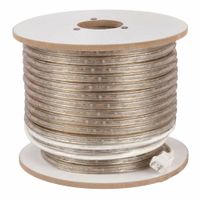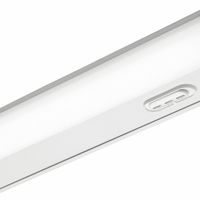Call +(254) 703 030 000 / 751 483 999 / 721 704 777
- Home
- Lighting
- Lighting Fixtures Retrofit Kits
- Under Cabinet Accent Lighting
Under-Cabinet & Accent Lighting
Under-cabinet and accent lighting supplements general lighting, provides task lighting, or highlights specific areas or features. Under-cabinet lights brighten countertops, shelves, desks, and other surfaces to eliminate shadows and illuminate areas where direct light is limited. Rope and tape light .....Read More
Frequently Asked Questions
What are the benefits of under-cabinet lighting?
Under-cabinet lighting offers several benefits that enhance both the functionality and aesthetics of a space. Firstly, it provides task lighting, which is crucial for activities such as cooking, reading recipes, or preparing food. This focused illumination reduces shadows on countertops, making tasks safer and more efficient. Secondly, under-cabinet lighting contributes to energy efficiency. By using LED lights, which are common in under-cabinet installations, energy consumption is minimized, leading to lower electricity bills and a reduced carbon footprint.
Aesthetically, under-cabinet lighting adds a modern and sophisticated look to kitchens and workspaces. It highlights the backsplash and countertops, enhancing the overall design and ambiance of the room. This type of lighting can also serve as accent lighting, creating a warm and inviting atmosphere, especially when other lights are dimmed or turned off.
Moreover, under-cabinet lighting is versatile and can be customized to fit various needs and preferences. Options include different light temperatures, dimmable features, and even smart lighting systems that can be controlled via apps or voice commands. This adaptability allows homeowners to tailor the lighting to their specific requirements and moods.
Installation of under-cabinet lighting is relatively straightforward and can be a cost-effective upgrade to any kitchen or workspace. It increases the value of a home by adding a desirable feature that potential buyers often appreciate. Additionally, it can be used in other areas such as bathrooms, offices, or workshops, providing the same benefits of improved visibility and enhanced design.
In summary, under-cabinet lighting is a practical and stylish addition that improves functionality, energy efficiency, and the aesthetic appeal of a space, making it a worthwhile investment for any home.
How do I install under-cabinet lighting?
1. **Choose Lighting Type**: Select between LED strips, puck lights, or fluorescent fixtures based on your preference and cabinet design.
2. **Gather Materials**: Purchase the lighting kit, a power drill, screws, a screwdriver, a measuring tape, a pencil, and wire connectors.
3. **Plan Layout**: Measure the cabinet length and mark where each light will be installed. Ensure even spacing for uniform lighting.
4. **Prepare the Area**: Clean the underside of the cabinets to ensure proper adhesion or mounting.
5. **Install Lights**:
- **LED Strips**: Cut the strip to the desired length if necessary. Peel off the adhesive backing and press the strip firmly under the cabinet.
- **Puck Lights**: Mark the screw holes using the light base as a template. Drill pilot holes and screw the puck lights into place.
- **Fluorescent Fixtures**: Mark the mounting holes, drill pilot holes, and secure the fixture with screws.
6. **Connect Wiring**:
- **Plug-in**: Simply plug the lights into an outlet.
- **Hardwired**: Turn off the power at the circuit breaker. Connect the wires from the lights to the power source using wire connectors. Match the colors: black to black (hot), white to white (neutral), and green or bare to ground.
7. **Hide Wires**: Use cable clips or adhesive channels to conceal and secure any visible wires.
8. **Test the Lights**: Turn the power back on and test the lights to ensure they work properly.
9. **Adjust and Secure**: Make any necessary adjustments to the positioning and ensure all components are securely fastened.
10. **Final Touches**: Tidy up the installation area and enjoy your new under-cabinet lighting.
What types of under-cabinet lighting are available?
Under-cabinet lighting options include:
1. **LED Strip Lights**: Flexible and energy-efficient, these strips can be cut to size and are available in various colors and brightness levels. They are ideal for providing even illumination across the countertop.
2. **Puck Lights**: Small, round fixtures that can be surface-mounted or recessed. They offer focused, spot lighting and are available in LED, halogen, or xenon options.
3. **Bar or Linear Lights**: These are long, narrow fixtures that provide uniform light distribution. They can be LED, fluorescent, or xenon, and are suitable for larger areas.
4. **Rope Lights**: Encased in a flexible tube, rope lights are easy to install and can be used for decorative or ambient lighting. They are less bright than other options.
5. **Tape Lights**: Similar to strip lights but thinner, tape lights are adhesive-backed and can be installed in tight spaces. They are typically LED and offer a range of color temperatures.
6. **Fluorescent Lights**: Known for their energy efficiency and long lifespan, fluorescent lights provide bright, cool light. They are less common now due to the rise of LED technology.
7. **Xenon Lights**: These provide a warm, bright light and are dimmable. They produce more heat and consume more energy compared to LEDs.
8. **Halogen Lights**: Offering bright, white light, halogen bulbs are less energy-efficient and generate more heat. They are being phased out in favor of LEDs.
9. **Smart Lighting**: Integrated with smart home systems, these lights can be controlled via apps or voice commands, offering adjustable brightness and color.
Each type has its own advantages and is chosen based on factors like energy efficiency, heat output, installation ease, and desired ambiance.
How do I choose the right under-cabinet lighting for my kitchen?
To choose the right under-cabinet lighting for your kitchen, consider the following factors:
1. **Purpose**: Determine if you need task lighting for food preparation, ambient lighting for mood, or accent lighting to highlight countertops.
2. **Type of Lighting**:
- **LED**: Energy-efficient, long-lasting, and available in various color temperatures.
- **Fluorescent**: Cost-effective and bright, but may flicker and have a limited color range.
- **Xenon**: Offers warm light and good color rendering but generates more heat and uses more energy.
- **Halogen**: Bright and warm, but less energy-efficient and hotter than LEDs.
3. **Color Temperature**: Choose between warm (2700K-3000K) for a cozy feel, neutral (3500K-4100K) for a balanced look, or cool (5000K-6500K) for a modern, daylight-like appearance.
4. **Brightness**: Measured in lumens, ensure the lighting is bright enough for tasks but not overwhelming. Around 200-500 lumens per foot is typical for task lighting.
5. **Installation**:
- **Plug-in**: Easy to install, ideal for renters.
- **Hardwired**: More permanent and seamless, requires professional installation.
- **Battery-operated**: Portable and easy to install, but requires frequent battery changes.
6. **Dimming Capability**: Opt for dimmable lights to adjust brightness according to needs and mood.
7. **Fixture Style**: Choose between light bars, puck lights, or tape lights based on aesthetics and coverage needs.
8. **Budget**: Balance between upfront costs and long-term energy savings. LEDs, though initially expensive, save money over time.
9. **Control Options**: Consider smart lighting for remote control via apps or voice commands.
Evaluate these factors based on your kitchen’s layout, personal preferences, and budget to select the most suitable under-cabinet lighting.
Can under-cabinet lighting be dimmable?
Yes, under-cabinet lighting can be dimmable. Dimmable under-cabinet lighting offers flexibility in adjusting the brightness to suit different tasks and moods. There are several types of under-cabinet lighting that can be dimmed:
1. **LED Lights**: Many LED under-cabinet lights are available with dimmable features. They are energy-efficient and have a long lifespan. Dimmable LED lights often require compatible dimmer switches or remote controls to adjust the brightness.
2. **Fluorescent Lights**: While less common, some fluorescent under-cabinet lights can be dimmed. However, they require specific dimmable ballasts and compatible dimmer switches.
3. **Halogen Lights**: Halogen lights can be dimmed easily and provide a warm light. They are less energy-efficient compared to LEDs but offer good color rendering.
4. **Xenon Lights**: These lights are similar to halogen but run cooler and can also be dimmed. They provide a warm, inviting light.
To ensure your under-cabinet lighting is dimmable, check the product specifications for compatibility with dimmer switches. Some systems come with built-in dimming capabilities, while others may require additional components like dimmer switches or remote controls.
When installing dimmable under-cabinet lighting, consider the following:
- **Compatibility**: Ensure the lights and dimmer switches are compatible. Not all dimmers work with all types of lights.
- **Wiring**: Proper wiring is essential for dimmable lights. Consult an electrician if unsure about installation.
- **Control Options**: Choose between wall-mounted dimmer switches, remote controls, or smart home integration for controlling the lights.
Dimmable under-cabinet lighting enhances functionality and ambiance, making it a versatile choice for kitchens, workspaces, and other areas where adjustable lighting is beneficial.
What is the difference between rope lights and tape lights?
Rope lights and tape lights are both popular lighting solutions, but they differ in design, application, and functionality.
Rope lights consist of small bulbs encased in a flexible, cylindrical PVC tube. This design makes them durable and weather-resistant, suitable for both indoor and outdoor use. They are often used for decorative purposes, such as outlining pathways, accentuating architectural features, or creating festive displays. Rope lights are available in various colors and can be cut to specific lengths, but they are generally less flexible in terms of installation due to their thicker profile.
Tape lights, also known as LED strip lights, feature a series of LED chips mounted on a flat, flexible circuit board. This design allows for a slimmer profile, making tape lights ideal for applications where space is limited, such as under cabinets, along shelves, or behind televisions. Tape lights are highly versatile, offering options for color-changing effects, dimming, and remote control. They often come with adhesive backing, simplifying installation on clean, smooth surfaces. However, tape lights are typically less durable in outdoor settings unless specifically designed for such use.
In summary, rope lights are robust and suitable for outdoor and decorative applications, while tape lights offer flexibility, ease of installation, and advanced lighting effects, making them ideal for indoor accent lighting.
How do I maintain and clean under-cabinet lighting?
To maintain and clean under-cabinet lighting, follow these steps:
1. **Turn Off Power**: Ensure the power to the lighting is turned off to prevent electrical hazards.
2. **Remove Covers**: If your lighting has covers or diffusers, carefully remove them. This may involve unscrewing or unclipping them, depending on the design.
3. **Dusting**: Use a microfiber cloth or a duster to remove dust from the lights and fixtures. This prevents dust buildup, which can dim the light output.
4. **Cleaning Bulbs and Fixtures**: For LED strips or bulbs, use a damp cloth with mild soap to gently wipe the surfaces. Avoid using abrasive cleaners or soaking the components, as moisture can damage electrical parts.
5. **Check for Damage**: Inspect the wiring and connections for any signs of wear or damage. Replace any frayed wires or faulty components to ensure safety and functionality.
6. **Reinstall Covers**: Once cleaned, dry all parts thoroughly and reinstall any covers or diffusers. Ensure they are securely fastened to prevent them from falling.
7. **Test the Lights**: Turn the power back on and test the lights to ensure they are working correctly. If any lights are not functioning, check the connections or replace the bulbs if necessary.
8. **Regular Maintenance**: Schedule regular cleaning every few months to maintain optimal performance and extend the lifespan of your under-cabinet lighting.
By following these steps, you can keep your under-cabinet lighting clean, efficient, and safe.



